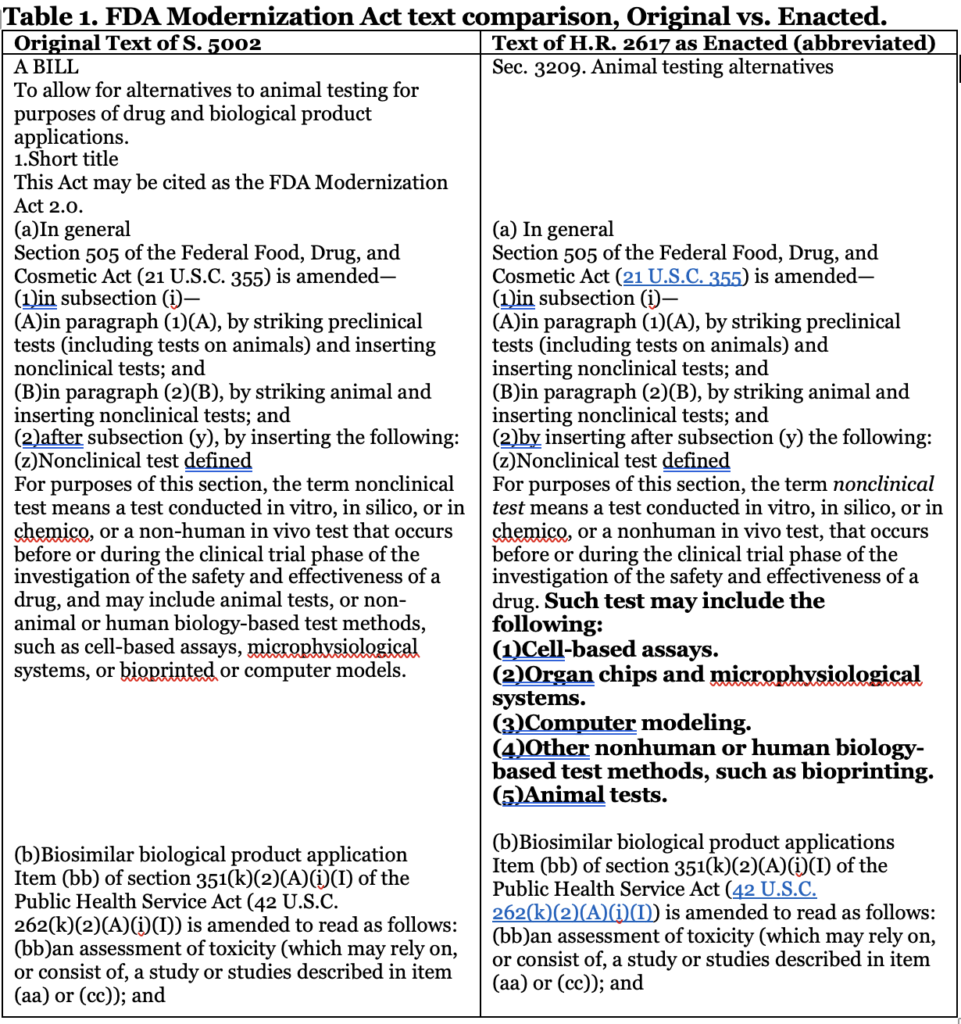The Impact of the FDA Modernization Act 2.0
Late in December 2022, President Biden signed H.R. 2617 (117th): Consolidated Appropriations Act into law. While boringly titled, this Act contained the FDA Modernization Act 2.0, proposed initially as S.5002. While this change is not as sweeping as the Food and Drug Administration Modernization Act of 1997, it will have a significant impact, which I discuss in this article.
Note: I used the AI Assist Drafting in Notion to generate some topics and content blocks.
Introduction
In January, a colleague asked me if I had heard of any fallout from the changes to the FD&C Act incorporated in the FDA Modernization Act of 2022. I want to explore this great question in this article. This act could have a wide range of implications for the health and safety of consumers and the regulation of the drug industry. We will look at the history of the legislation and examine some of the possible outcomes that may arise from its implementation in greater detail.

The FDA Modernization Act of 2022 is an act that aims to update the Food and Drug Administration’s policies to meet the changing needs of the modern world. Introduced by Senator Rand Paul on September 29th, 2022 [1], it was considered and passed in the Senate on that date. The original bill was three pages long and contained two key points:
1. Changing three references (two in the NDA section and one in the BLA section) from animal tests to nonclinical tests.
2. Defining nonclinical tests as “a test conducted in vitro, in silico, or in chemico, or a non-human in vivo test that occurs before or during the clinical trial phase of the investigation of the safety and effectiveness of a drug, and may include animal tests, or non-animal or human biology-based test methods, such as cell-based assays, microphysiological systems, or bioprinted or computer models.” [1]
Before I read it, I thought there was a lot more to this bill.
What Was Passed
However, other legislative priorities sidelined this bill until December, when Representatives incorporated 83% of the original legislation into the Consolidated Appropriations Act, 2023 (H.R. 2617) [2]. I found this note intriguing – what pieces were left out? Table 1 shows an abbreviated version of the comparison I found using the links on the H.R 2617 site. I’ve inserted spaces so you can see the relevant text side by side. I’ve also marked the change in the Enacted text in bold font. As you can see, the modifications simply clarify the definition of a nonclinical test. The final legislation also omitted the description of the bill and its short title, though you will still see reference to it in the press.

What is the Impact of this Change?
One outcome of the change will be clarifying the use of nonclinical as a term for safety and effectiveness testing occurring outside the scope of a clinical trial, regardless of the candidate’s phase. Preclinical usually refers to tests before a candidate enters the clinic. The FDA defines nonclinical laboratory studies in 21CFR Part 58, Good Laboratory Practice for Nonclinical Laboratory Studies, as
“in vivo or in vitro experiments in which test articles are studied prospectively in test systems under laboratory conditions to determine their safety. The term does not include studies utilizing human subjects or clinical studies, or field trials in animals. The term does not include basic exploratory studies carried out to determine whether a test article has any potential utility or to determine physical or chemical characteristics of a test article.” [3]

These nonclinical studies often relied heavily on animal models because they dominate the knowledge base for drug safety evaluations. The Premier Consulting team posted an excellent overview of the standard studies needed here. However, animal studies are lengthy, expensive, and freighted with ethical questions, so many researchers have explored alternate methods. I assess that this change facilitates the use of data from non-animal safety assessments in submissions and, eventually, their long-term acceptance as equivalent measures. Also important is stimulating the development of existing and new tools (organ chips, microphysiological systems, and bioprinted models are just a few examples). There is the potential for significant growth in contract research services from startups with platform technologies. Supply chain issues continue to trouble the nonclinical study space, increasing costs and limiting access to nonhuman primate studies for the required safety testing of biological drugs. New tools will be necessary to move away from this paradigm. Lastly, changes in the Act often lead to new guidance, allowing the FDA to express its current thinking on regulatory science and stimulating new or expanded contract service offerings.

‘m not the only one thinking this is an appropriate change. The outcome of conversations hosted by various stakeholders in 2017-2018 led to an article advocating changes to advance innovation in nonclinical pharmaceutical testing. [4] One of their top recommendations was changing regulatory and policy requirements from “animal” data to “nonclinical.” The National Association for Biomedical Research continues to point out that “Animal testing followed by human clinical trials currently remains the best way to examine complex physiological, neuroanatomical, reproductive, developmental and cognitive effects of drugs to determine if they are safe and effective for market approval.” However, they acknowledge the importance of allowing FDA reviewers to determine the best data for any particular NDA. [5] And a 2020 commentary by FDA/CDER authors discussed the opportunities and challenges of these new approaches and encouraged stakeholders to engage regulators. [6]
Some Other Observations
H.R. 2617 includes many other elements amending the Food, Drug, and Cosmetic Act (once you get past the appropriations acts (Divisions A-M)). There are sections on emergency preparedness, enhancing development and combating shortages of medical products, reauthorizations of programs like the humanitarian device exemption incentives and the third-party review program, calls for reports on subjects like the orphan drug program, designation of National Centers of Excellence in Advanced and Continuous Pharmaceutical Manufacturing, and many others. There are a total of 185 references to the Act in the legislation. I don’t know how anyone keeps this straight. The table of contents is of limited value, and there is no index.

In Closing
The FDA Modernization Act of 2022 is a relatively small piece of legislation that could have a far-reaching impact on how we develop new medicines. That impact will largely depend on informed conversations between industry experts and regulators. The efforts of entrepreneurs to address the genuine challenges of establishing benchmarks for new safety and efficacy measurements will also be necessary. Innovation is central to this work, so I expect we will see exciting outcomes soon.
My sincere thanks to Matthew Jones for the conversation that prompted this article. Please keep those questions coming!
[1] GovTrack.us, Congressional Bills, S. 5002 (117th), FDA Modernization Act 2.0. Accessed February 24, 2023. https://www.govtrack.us/congress/bills/117/s5002
[2] GovTrack.us, Congressional Bills, H.R.2617 (117th), Consolidated Appropriations Act, 2023. Accessed February 24, 2023. https://www.govtrack.us/congress/bills/117/hr2617
[3] eCFR.gov, accessed March 24, 2023. https://www.ecfr.gov/current/title-21/chapter-I/subchapter-A/part-58
[4] Baker EJ, Beck NA, Berg EL, Clayton-Jeter HD, Chandrasekera PC, Curley JL, Donzanti BA, Ewart LC, Gunther JM, Kenna JG, LeCluyse EL, Liebman MN, Pugh CL, Watkins PB, Sullivan KM. Advancing nonclinical innovation and safety in pharmaceutical testing. Drug Discov Today. 2019 Feb;24(2):624-628. doi: 10.1016/j.drudis.2018.11.011. Epub 2018 Nov 20. PMID: 30468877. Accessed March 24, 2023. https://www.sciencedirect.com/science/article/pii/S1359644618302642
[5] NABR’s press statement on the FDA Modernization Act 2.0, Thursday, January 12, 2023 , accessed March 24, 2023. https://www.nabr.org/about-nabr/news/nabrs-press-statement-fda-modernization-act-20
[6] Avila, A. M., Bebenek, I., Bonzo, J. A., Bourcier, T., Davis Bruno, K. L., Carlson, D. B., . . . Brown, P. C. (2020). An FDA/CDER perspective on nonclinical testing strategies: Classical toxicology approaches and new approach methodologies (NAMs). Regulatory Toxicology and Pharmacology, 114, 104662. Accessed March 24, 2023. doi: https://doi.org/10.1016/j.yrtph.2020.104662
If you enjoyed this article and would like to read more by Katrina, sign up for her newsletter.
